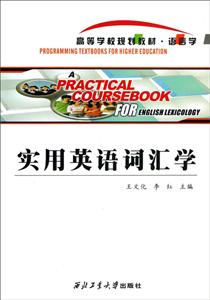-
>
分類速記英語單詞4000個(口袋本)
-
>
新東方 背單詞,記住這200個詞根詞綴就夠了
-
>
(精)古代漢語三百題
-
>
增廣賢文
-
>
優(yōu)秀的綿羊
-
>
北京大學(xué)
-
>
校園英語即學(xué)即用(附光盤)
實(shí)用英語詞匯學(xué) 版權(quán)信息
- ISBN:9787561237632
- 條形碼:9787561237632 ; 978-7-5612-3763-2
- 裝幀:一般膠版紙
- 冊數(shù):暫無
- 重量:暫無
- 所屬分類:>
實(shí)用英語詞匯學(xué) 本書特色
為了使英語學(xué)習(xí)者對英語詞匯有一個系統(tǒng)、全面的了解,《實(shí)用英語詞匯學(xué)》系統(tǒng)地介紹了英語詞匯學(xué)的相關(guān)理論,主要包括:①英語詞匯的結(jié)構(gòu)及構(gòu)成方式;②英語詞匯的意義、轉(zhuǎn)變以及與語境的關(guān)系;③英語詞匯的搭配特點(diǎn)及英語慣用語、諺語和語塊;④英語詞匯的比喻用法;⑤英語詞匯的性別特點(diǎn),敬語及委婉語特點(diǎn);⑥英語詞匯的文化內(nèi)涵;⑦不同的英語國家的英語詞匯特點(diǎn)差異;⑧英語新詞及英語詞匯學(xué)習(xí)策略;⑨不同類型的英語詞典及其用法等。王文化、李紅負(fù)責(zé)全書的統(tǒng)稿、修訂工作。
實(shí)用英語詞匯學(xué) 內(nèi)容簡介
《實(shí)用英語詞匯學(xué)/高等學(xué)校規(guī)劃教材·語言學(xué)》突破了傳統(tǒng)的詞匯學(xué)教材格局,吸收了語言學(xué)相關(guān)分支學(xué)科的*新研究成果,注重英語詞匯的交際價值,強(qiáng)調(diào)培養(yǎng)學(xué)生的詞匯能力,是一本理論與實(shí)踐并重的新教材。《實(shí)用英語詞匯學(xué)/高等學(xué)校規(guī)劃教材·語言學(xué)》內(nèi)容涵蓋了英語詞匯的構(gòu)成、意義、搭配、使用、學(xué)習(xí)策略及詞典等方面,角度多元,內(nèi)容豐富,展現(xiàn)了全新的當(dāng)代英語詞匯學(xué)視野。各章練習(xí)力圖式樣靈活,使學(xué)生無需死記硬背就可以鞏固所學(xué)知識。《實(shí)用英語詞匯學(xué)/高等學(xué)校規(guī)劃教材·語言學(xué)》既有共時的研究,又有歷時的視角,試圖使學(xué)生在掌握詞匯學(xué)的基本概念和內(nèi)容的同時,將他們引導(dǎo)到詞匯這一英語語言中*具人文色彩的部分。 《實(shí)用英語詞匯學(xué)/高等學(xué)校規(guī)劃教材·語言學(xué)》主要供高等院校英語專業(yè)本科高年級學(xué)生和研究生,及其他英語語言學(xué)研究者使用。王文化、李紅負(fù)責(zé)全書的統(tǒng)稿、修訂工作。
實(shí)用英語詞匯學(xué) 目錄
1.1 Words
1.2 Vocabulary
1.3 Lexicology
1.4 The Classification of English Words
Exercises
Chapter 2 Formation of English Words
2.1 The Structure of English Words
2.2 Derivation
2.3 Conversion
2.4 Compounding (Compound/Composition)
2.5 Acronym
2.6 Clipping
2.7 Blending
2.8 Back-formation
2.9 Words from Proper Names
2.10 Reduplication
Exercises
Chapter 3 Word Meaning
3.1 Definition of Meaning
3.2 Word Meaning
3.3 Sense and Componential Analysis
3.4 Semantic Relations among English Words
Exercises
Chapter 4 Changes in Word Meaning
4.1 Types of Change
4.2 Causes of Change
Exercises
Chapter 5 Chunks, Collocations, Idioms and Proverbs in English
5.1 Chunks in English
5.2 Collocations in English
5.3 Idioms in English
5.4 Proverbs in English
Exercises
Chapter 6 English Words in Context
6.1 Definition of Context
6.2 Lexical Meaning and the Context
6.3 The Role of the Context
6.4 Using Context Clues to Learn Word Meaniiag
Exercises
Chapter 7 Figurative Uses of English Words
7.1 An Introduction to Figures of Speech
7.2 English Words in Metaphor
7.3 Other Figurative Uses of English Words
Exercises
Chapter 8 Social Aspect of English Words
8.1 Gender and English Words
8.2 Honorifics in English
8.3 Euphemisms in English
Exercises
Chapter 9 English Words and Culture
9.1 Color Terms and Culture
9.2 Numerals and Culture
9.3 Euphemisms and Culture
9.4 Idioms and Culture
Exercises
Chapter 10 The Lexical Features of Major English-speaking Countries
10.1 English as a World Language
10.2 British and American English
10.3 Canadian English
10.4 Australian English
10.5 New Zealand English
10.6 South African English
Exercises
Chapter 11 The New Development of English Vocabulary
11.1 What Are Neologisms?
11.2 Research on New Words and the Reason for Why Study New Words
11.3 The Development of English Neologisms
11.4 The Main Reasons for the Appearance of English Neologisms
11.5 How New Words Come to Be
11.6 The Qualities of Helping a New Word Survive
Exercises
Chapter 12 English Vocabulary Learning
12.1 Introduction of English Vocabulary Learning
12.2 How to Learn English Vocabulary
12.3 How to Avoid Forgetting the Vocabulary That I Have Learned
12.4 Other Tips for English Vocabulary Learning
Exercises
Chapter 13 English Dictionaries and How to Use Them
13.1 Introductory Remarks
13.2 History of English Dictionaries
13.3 Types of Dictionaries
13.4 How to Use a Dictionary
Exercises
Appendix 1 Lexicology Terms (English-Chinese)
Appendix 2 Some Common Prefixes
Appendix 3 Some common Suffixes
Appendix 4 Types of Figures of Speech
Appendix 5 A List of Euphemisms
Key to Exercises
References
- >
姑媽的寶刀
- >
上帝之肋:男人的真實(shí)旅程
- >
李白與唐代文化
- >
山海經(jīng)
- >
史學(xué)評論
- >
隨園食單
- >
苦雨齋序跋文-周作人自編集
- >
詩經(jīng)-先民的歌唱
-
新核心高職英語C版綜合教程.2
¥26.9¥39.8















